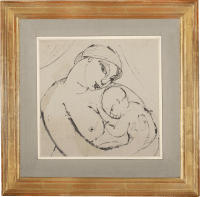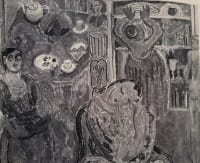Duncan Grant was a central figure in the Bloomsbury Group, a collective of artistic individuals who embraced a progressive, bohemian lifestyle and championed modern art in Britain. This sensitive drawing of a mother and child was produced at the dawn of Grant’s entrance into the avant-garde art scene.
Mother and Child relates to Grant’s large interior painting The Kitchen of the same year [fig. 1]. Richard Shone has suggested that the present work is almost certainly a preliminary idea for the mother and child in the foreground. [1] The Kitchen was exhibited by Roger Fry in the Omega Workshops’ first mixed-subject show of paintings in 1917.[2] Grant played a leading role in the Omega Workshops – which was founded in 1913 by Roger Fry - and assisted in the production of furniture, ceramics, pottery and textiles. The 1917 exhibition included at least 20 oil paintings and opened to the public on 10 November to great acclaim. The Kitchen entered the...
Duncan Grant was a central figure in the Bloomsbury Group, a collective of artistic individuals who embraced a progressive, bohemian lifestyle and championed modern art in Britain. This sensitive drawing of a mother and child was produced at the dawn of Grant’s entrance into the avant-garde art scene.
Mother and Child relates to Grant’s large interior painting The Kitchen of the same year [fig. 1]. Richard Shone has suggested that the present work is almost certainly a preliminary idea for the mother and child in the foreground. [1] The Kitchen was exhibited by Roger Fry in the Omega Workshops’ first mixed-subject show of paintings in 1917.[2] Grant played a leading role in the Omega Workshops – which was founded in 1913 by Roger Fry - and assisted in the production of furniture, ceramics, pottery and textiles. The 1917 exhibition included at least 20 oil paintings and opened to the public on 10 November to great acclaim. The Kitchen entered the collection of John Maynard Keynes and is now at King’s College, Cambridge.
Stylistically, Mother and Child reveals Grant's interest in a wide range of influences, as Richard Shone suggests; ‘borrowings and influences - from the Byzantine, from Picasso, from Persian miniatures, from newspaper photographs and "contemporary" life ... from Matisse, the Bible and the early Italians - are used in an intoxicating shuffle and reshuffle, all equally suitable and suggestive as catalysts to work'.[3] The ‘mask-like’ face, simplified in its form, is entirely in keeping with Grant’s work for the period and further demonstrates his engagement with the work of European artists such as Pablo Picasso. The decorative quality of this drawing also strongly relates to the wider ethos of the Omega Workshops and bears compositional similarities to a painted ceramic by Duncan Grant, dated to the same year [fig. 2].
The present work was acquired by Captain Crawford Flitch, an early twentieth-century writer and collector of modern British works. Flitch likely acquired the work through a personal relationship with Grant’s circle, given that Grant was not exhibiting drawings such as Mother and Child at this date. Flitch was a near-contemporary of Keynes at Cambridge and may have made contact with Grant through this connection.
[1] Christie's, London, ‘Modern/British Art Online’, 24 November 2017, lot. 115.
[2] J. Collins, The Omega Workshops. London: Secker & Warburg, 1984, p. 155.
[3] R. Shone, Bloomsbury Portraits. London, Phadion.















